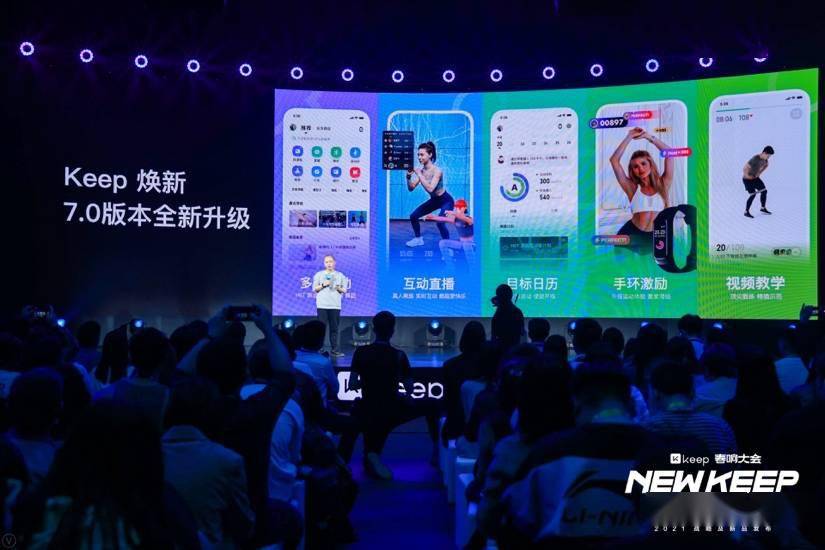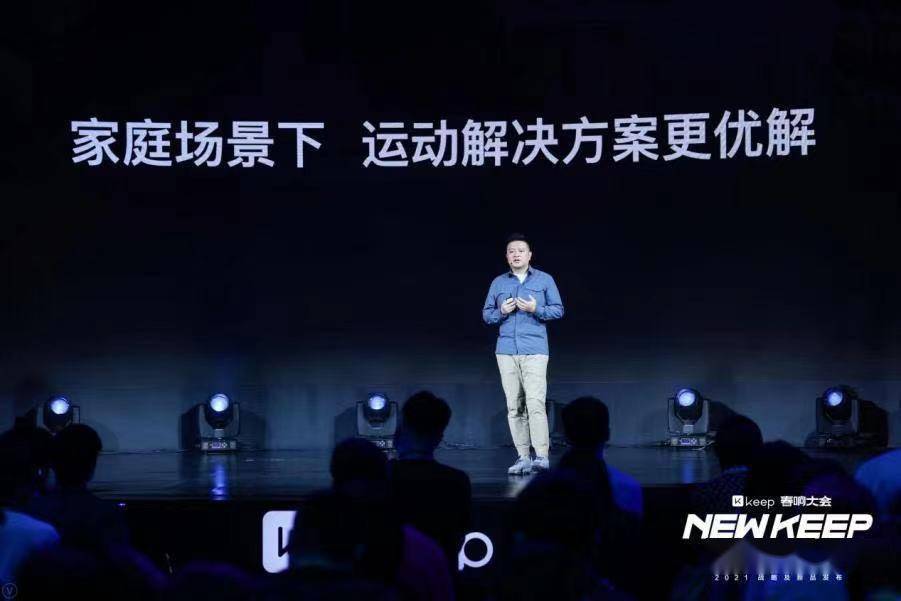Author|Hu describe editor|Luo Lijuan
The “cloud fitness” boom continues.
On April 21st, the sports social platform Keep released the 7.0 version of the APP at the “2021 Spring Ring Conference”, and launched three new upgraded IP courses and the Keep smart spinning bike C1 Pro and Keep bracelet. B2 members enjoy two smart hardware products.

Huang Jingjing, vice president of Keep, said at the meeting that Keep will launch a celebrity coach team, and the interaction between coaches and users will also be upgraded, “I hope to create Li Jiaqi in the live fitness session.” In addition, keep’s premium live courses have been covered throughout the day, from 8 am to 22:00 at any time to meet the sports needs of users at different times.
Since its launch in 2015, Keep has been developing for 6 years and now has a scale of 300 million users. In January of this year, it completed a huge US$360 million round of financing. This round of financing was led by SoftBank Vision Fund, Hillhouse Capital, Gaodu Capital and other old shareholders such as GGV Jiyuan Capital, Tencent, Wuyuan Capital (formerly Morningside Capital), Times Capital and BAI Capital continued to invest more . After completing the financing, keep’s valuation reached 2 billion US dollars.
Recently, news broke that Keep has appointed a CFO and recruited directors of investor relations through multiple channels, and submitted a prospectus to the U.S. Securities and Exchange Commission (SEC) as early as the end of April 2021 to apply for listing in the United States.
Although Keep responded that: “There is no more news to announce.” But China’s sports social platform has indeed stood on the “outlet.”
Looking overseas, the share price of American online fitness giant Peloton has risen from US$27 per share at the end of April last year to the current US$99.93 per share, an increase of 270% during the year and a market value of US$29.43 billion.
And will Keep be the next Peloton? This is the question of people outside the industry and the expectation of many investors.

Liu Dong, co-founder and vice president of keep
After this press conference, Liu Dong, co-founder and vice president of Keep, had a dialogue with the media on the company’s current business segments and business monetization model. The following is the content of the dialogue, organized by 24/7 technology:
Q: This year’s technology fitness track is particularly popular. What do you think ?
Liu Dong: I think we are at a stage where there is no end and I don’t know what the future endgame will look like. It’s just that every company or track has a different approach.
Peloton leads the rise in the United States. I believe that no one in China will invest in a company that makes sports apps, but start investing in companies that have sports hardware. In the future, technology will change the experience. I understand that the sports experience upgrade will be upgraded from coaching, feedback, and interaction together, because it can restore the offline experience, but it may be upgraded based on feedback. If we look back a little longer, starting with Nintendo’s Switch, whether it is a gamified sport or a sporty game, I think there are many questions that can be explored.
For Keep, we are definitely catching what we are best at. We have coaches, so we will do live broadcasts. It is possible that this is a threshold. There are only so many coaches in China. Through online and offline, coaches can produce good content. Maybe this thing is more difficult, so we start with the hardest thing.
Q: Keep announced that its annual sales have reached 1 billion. Can you announce the specific revenue share, which is the largest revenue?
Liu Dong: One billion is the sales of consumer products, not including online business and advertising business. From a comprehensive perspective of the three businesses, the first is the consumer goods business, the second is the advertising business, and the third is the membership service business. Our revenue is composed of these three parts. The sales will be a little more than the other two businesses combined. Consumer products still depend on scale, but members’ business profits will be better.
Keep is currently profitable. Online is our largest APP investment. When members have online income, it is also a high-margin Internet product and service, so it can cover this part of the cost.
Consumer goods can increase users’ repurchase in terms of eating, wearing, using, and training. You buy clothing for sports and food for sports. In fact, repurchase is a relatively large increase. In addition, the gross profit of food and clothing is definitely better than that of smart hardware. The overall environment is a healthier.
On the other hand, our users are Keep APP users, and we may not need to grow like the growth of other consumer products, such as the growth method of Perfect Diary. The overall development is still in a relatively benign state, and it is indeed easier to make a profit in this state.
But whether we want to continue to make profits depends on our future plans. We believe that at this stage, we need to make some investment. From a strategic point of view, we have made it clear that we must do this on the platform, content, and smart hardware.
Q: Among consumer products, which category has the highest GMV? In terms of food, how does Keep compete with businesses that specialize in this type of product?
Liu Dong: Our biggest category is still smart products , Keep is serious about the experience direction, this thing users can feel, so the fastest growing is the smart product, and the largest share is also the smart product.
The homogeneity of food may be more serious. The entire supply chain in China is basically relatively transparent, so our food is more integrated with the scene, and we have not invented and created products. In fact, food is quite difficult. It is a fast-moving consumer product and needs to constantly reach users and tell him the latest tastes. It’s not like buying a dumbbell. I’ll search for it and evaluate which one is better. But our current scale is still more than 100 million. For a new Internet company, we think it is a relatively good result.
Our current consumer products are planned from eating, wearing, using, and practicing. In “practice” or “use”, there will be many different product categories, but we are still focusing on the family scene. Like basketball and football, each piece is very big, but we didn’t involve in this field. We believe that when the family scenario is not good enough, we will not do basketball or football, so there is some restraint in the expansion of the category.
Q: A few years ago, Keep did Keepland. What is its current position and contribution role?
Liu Dong: The original intention of Keepland in 2017 is parallel to the content connecting the family. A connecting family and a connecting city will allow you to train more. At that time, we defined it as “infrastructure.”
In the subsequent development, the consumer goods business or online business develops very fast, offline is a slow process, and the speed is certainly not as fast as other online businesses, plus the impact of the previous epidemic. So Keepland has been doing it all the time, just saying that it makes it more stable compared to faster business. I personally think that Keepland can be counted as an online live broadcast business, an incubator for the coaching team, or the “Whampoa Military Academy”, because the cognition generated there can be amplified through the Internet.
There are now 9 Keepland stores in Beijing, which has hardly changed from the previous figures. We will not shrink it or expand it excessively.
Q: A piece of data was shared at the press conference, serving 1.56 million. Is this a user who spends money on consumer goods on Keep? How much space is there in this field?
Liu Dong: There are far more than 1.56 million users who buy consumer goods, and 1.56 million are just users who buy smart products. If the scale is 1 billion per year, the number of users per year is about several million.
Maybe three years ago, we only had a scale of 30-40 million, and after three years we will reach a scale of 1 billion+. We will definitely continue to maintain this growth rate. Moreover, from the current ceiling, there is still a lot of room. For example, we mainly focus on e-commerce channels. Now we only focus on JD.com, Tmall and our own malls. Other platforms have not yet done so. Second, there are also channels for sub-sales, as well as live broadcasts, communities, and even offline. This space is still very large.




























































You must log in to post a comment.